Leadership Styles Impact on Project Team Performance Report
VerifiedAdded on 2020/05/11
|7
|1316
|137
Report
AI Summary
This report delves into the realm of organizational behavior and people management, specifically focusing on the selection and implementation of leadership styles within an organization, particularly during project launches. It emphasizes the importance of choosing a leadership style that motivates employees, fosters teamwork, and aligns with organizational objectives. The report explores the application of team leadership and transformational leadership styles, highlighting their role in improving communication and building strong team bonds. Furthermore, it examines the tools used by project managers to influence their teams, including effective communication and assessment tools. The report also identifies five types of power—legitimate, reward, expert, referent, and punishment—and explains their roles in motivating work collaboration. It provides insights into the steps project managers can take to resolve challenges, such as implementing interpersonal communication theories and training programs. The report concludes by underscoring the significance of choosing effective leadership styles to enhance interpersonal skills and ensure ethical conduct within project teams.
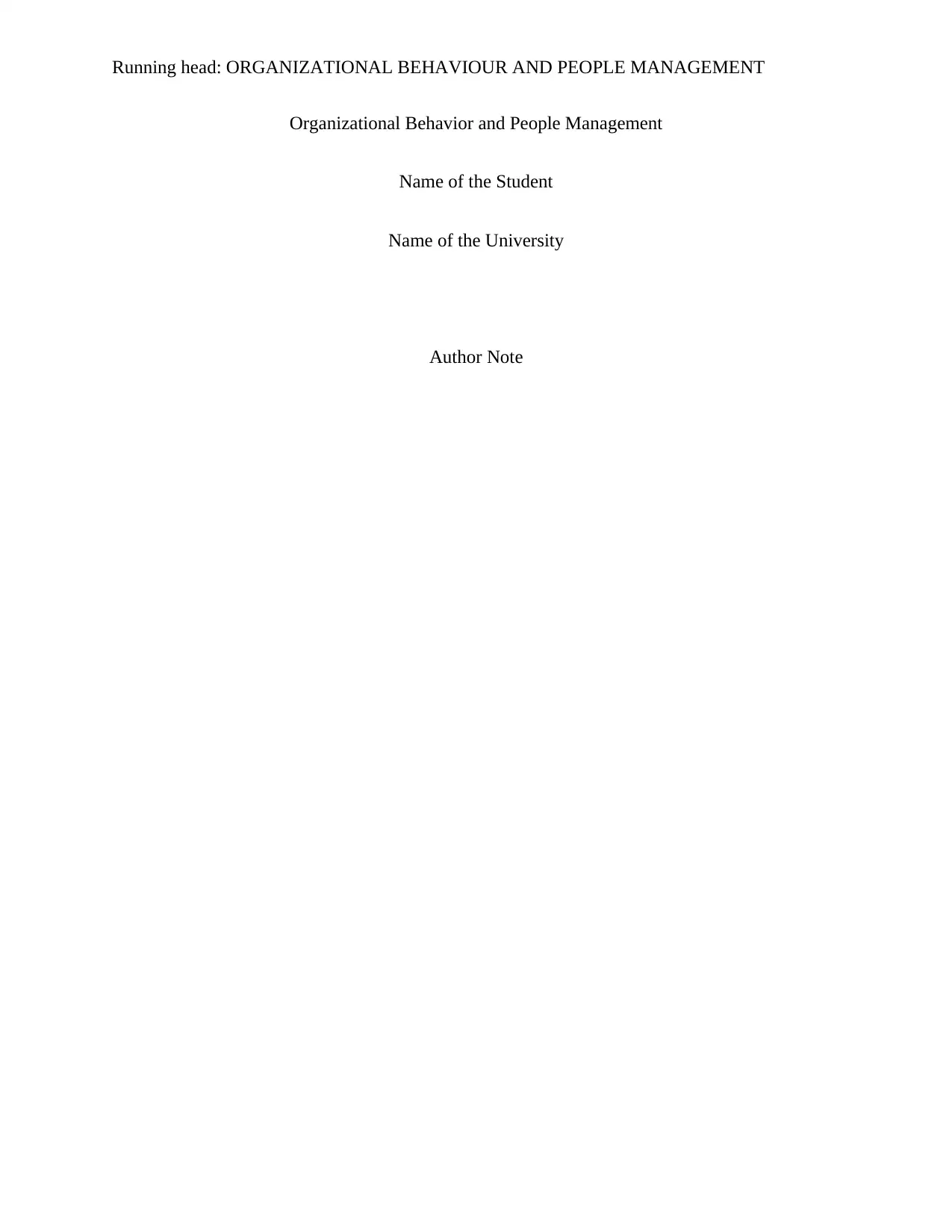
Running head: ORGANIZATIONAL BEHAVIOUR AND PEOPLE MANAGEMENT
Organizational Behavior and People Management
Name of the Student
Name of the University
Author Note
Organizational Behavior and People Management
Name of the Student
Name of the University
Author Note
Paraphrase This Document
Need a fresh take? Get an instant paraphrase of this document with our AI Paraphraser
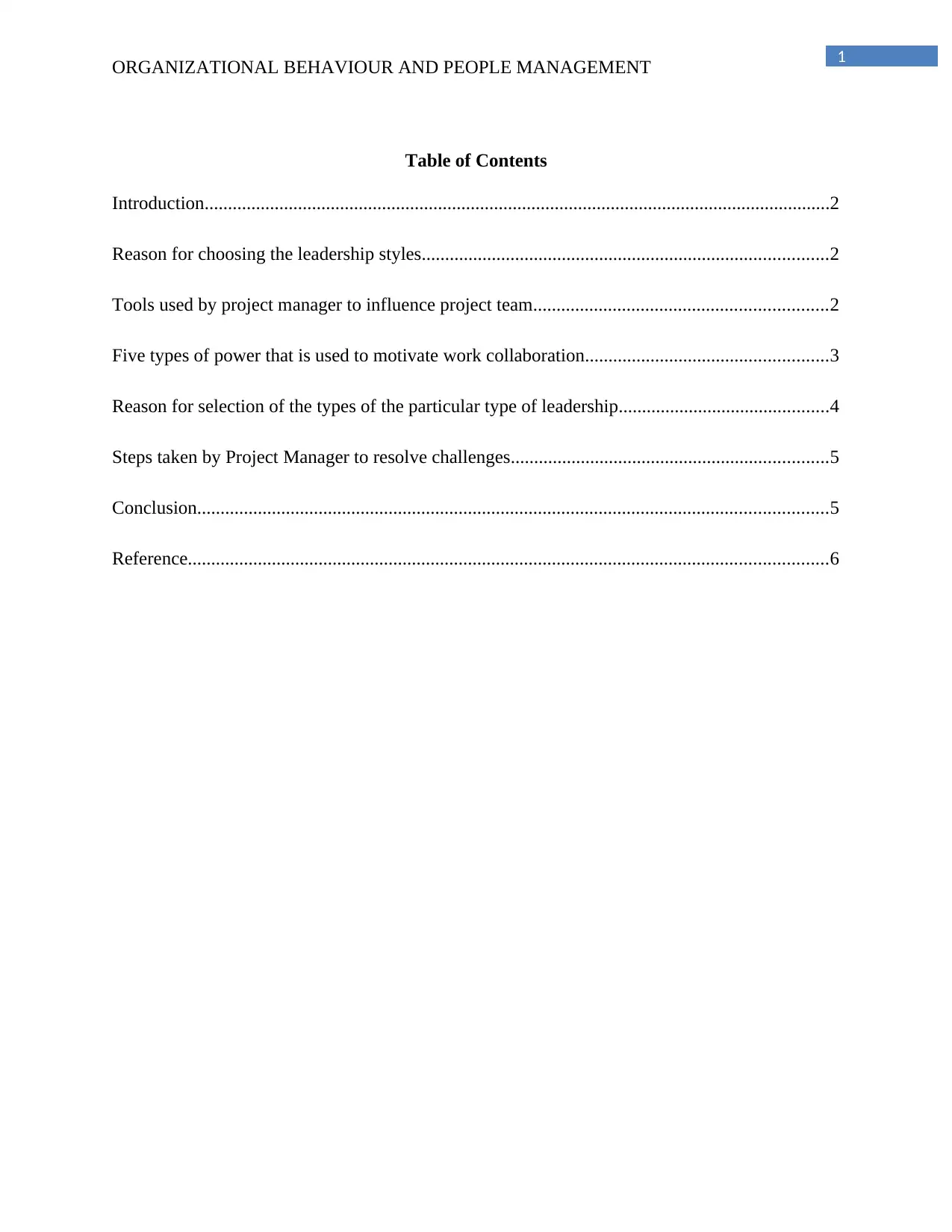
1
ORGANIZATIONAL BEHAVIOUR AND PEOPLE MANAGEMENT
Table of Contents
Introduction......................................................................................................................................2
Reason for choosing the leadership styles.......................................................................................2
Tools used by project manager to influence project team...............................................................2
Five types of power that is used to motivate work collaboration....................................................3
Reason for selection of the types of the particular type of leadership.............................................4
Steps taken by Project Manager to resolve challenges....................................................................5
Conclusion.......................................................................................................................................5
Reference.........................................................................................................................................6
ORGANIZATIONAL BEHAVIOUR AND PEOPLE MANAGEMENT
Table of Contents
Introduction......................................................................................................................................2
Reason for choosing the leadership styles.......................................................................................2
Tools used by project manager to influence project team...............................................................2
Five types of power that is used to motivate work collaboration....................................................3
Reason for selection of the types of the particular type of leadership.............................................4
Steps taken by Project Manager to resolve challenges....................................................................5
Conclusion.......................................................................................................................................5
Reference.........................................................................................................................................6
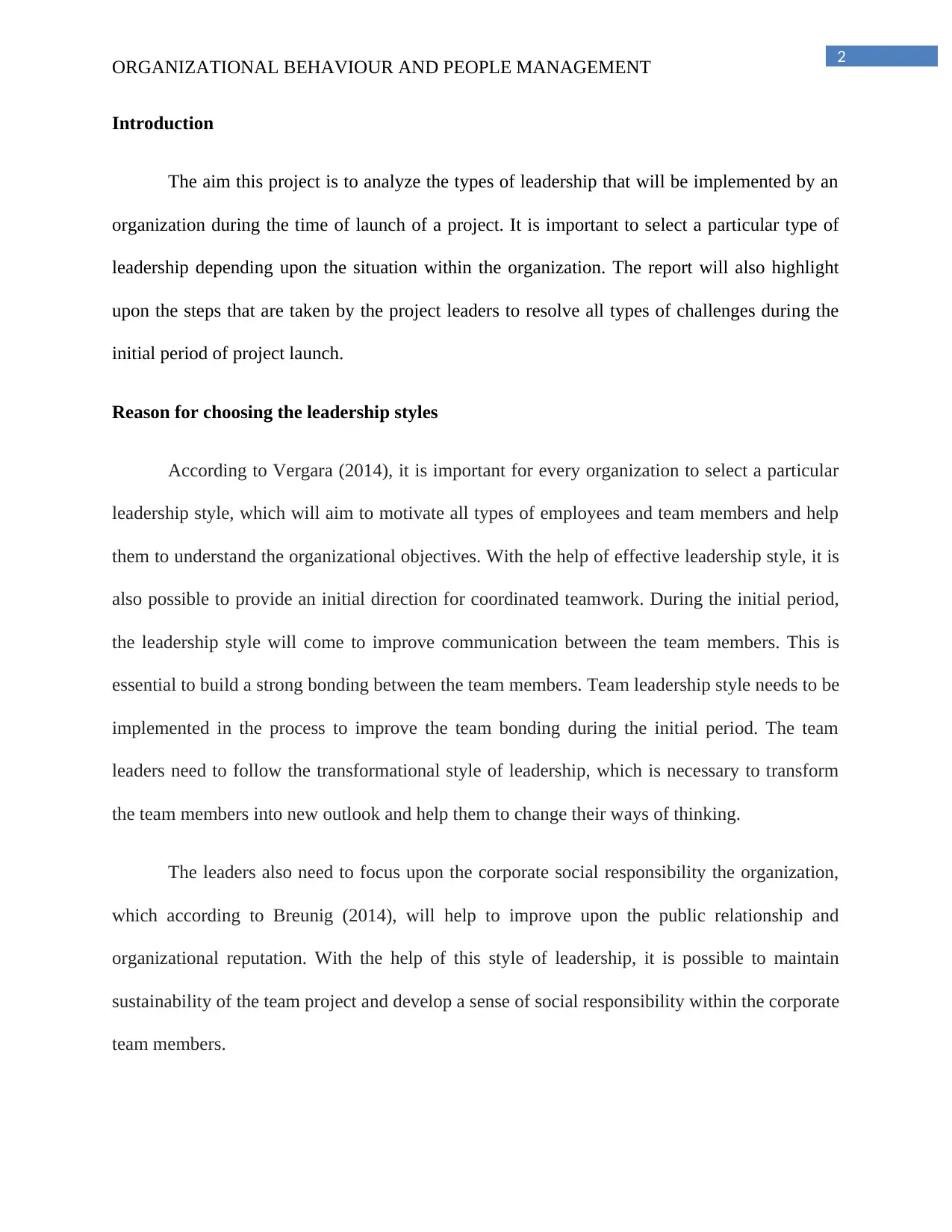
2
ORGANIZATIONAL BEHAVIOUR AND PEOPLE MANAGEMENT
Introduction
The aim this project is to analyze the types of leadership that will be implemented by an
organization during the time of launch of a project. It is important to select a particular type of
leadership depending upon the situation within the organization. The report will also highlight
upon the steps that are taken by the project leaders to resolve all types of challenges during the
initial period of project launch.
Reason for choosing the leadership styles
According to Vergara (2014), it is important for every organization to select a particular
leadership style, which will aim to motivate all types of employees and team members and help
them to understand the organizational objectives. With the help of effective leadership style, it is
also possible to provide an initial direction for coordinated teamwork. During the initial period,
the leadership style will come to improve communication between the team members. This is
essential to build a strong bonding between the team members. Team leadership style needs to be
implemented in the process to improve the team bonding during the initial period. The team
leaders need to follow the transformational style of leadership, which is necessary to transform
the team members into new outlook and help them to change their ways of thinking.
The leaders also need to focus upon the corporate social responsibility the organization,
which according to Breunig (2014), will help to improve upon the public relationship and
organizational reputation. With the help of this style of leadership, it is possible to maintain
sustainability of the team project and develop a sense of social responsibility within the corporate
team members.
ORGANIZATIONAL BEHAVIOUR AND PEOPLE MANAGEMENT
Introduction
The aim this project is to analyze the types of leadership that will be implemented by an
organization during the time of launch of a project. It is important to select a particular type of
leadership depending upon the situation within the organization. The report will also highlight
upon the steps that are taken by the project leaders to resolve all types of challenges during the
initial period of project launch.
Reason for choosing the leadership styles
According to Vergara (2014), it is important for every organization to select a particular
leadership style, which will aim to motivate all types of employees and team members and help
them to understand the organizational objectives. With the help of effective leadership style, it is
also possible to provide an initial direction for coordinated teamwork. During the initial period,
the leadership style will come to improve communication between the team members. This is
essential to build a strong bonding between the team members. Team leadership style needs to be
implemented in the process to improve the team bonding during the initial period. The team
leaders need to follow the transformational style of leadership, which is necessary to transform
the team members into new outlook and help them to change their ways of thinking.
The leaders also need to focus upon the corporate social responsibility the organization,
which according to Breunig (2014), will help to improve upon the public relationship and
organizational reputation. With the help of this style of leadership, it is possible to maintain
sustainability of the team project and develop a sense of social responsibility within the corporate
team members.
⊘ This is a preview!⊘
Do you want full access?
Subscribe today to unlock all pages.

Trusted by 1+ million students worldwide
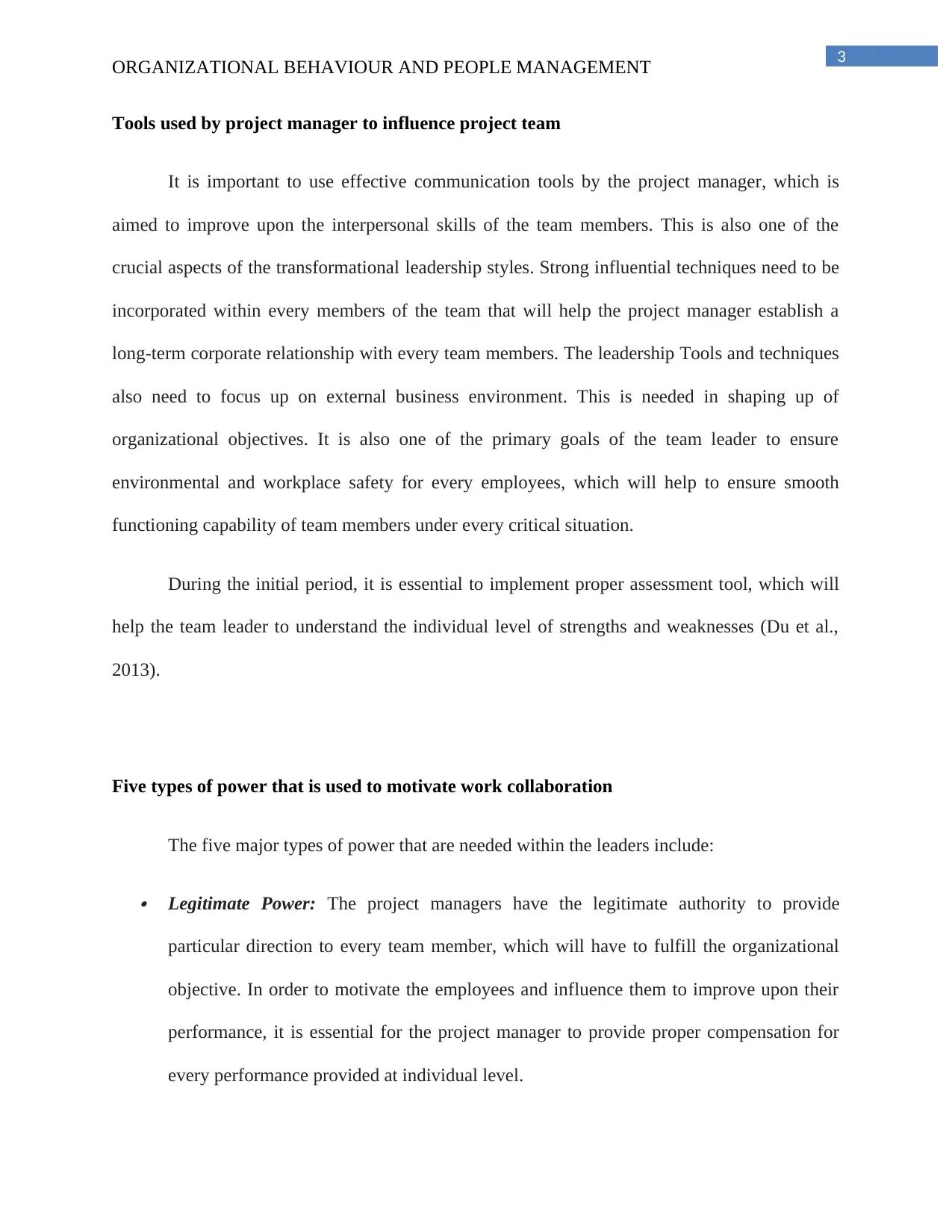
3
ORGANIZATIONAL BEHAVIOUR AND PEOPLE MANAGEMENT
Tools used by project manager to influence project team
It is important to use effective communication tools by the project manager, which is
aimed to improve upon the interpersonal skills of the team members. This is also one of the
crucial aspects of the transformational leadership styles. Strong influential techniques need to be
incorporated within every members of the team that will help the project manager establish a
long-term corporate relationship with every team members. The leadership Tools and techniques
also need to focus up on external business environment. This is needed in shaping up of
organizational objectives. It is also one of the primary goals of the team leader to ensure
environmental and workplace safety for every employees, which will help to ensure smooth
functioning capability of team members under every critical situation.
During the initial period, it is essential to implement proper assessment tool, which will
help the team leader to understand the individual level of strengths and weaknesses (Du et al.,
2013).
Five types of power that is used to motivate work collaboration
The five major types of power that are needed within the leaders include:
Legitimate Power: The project managers have the legitimate authority to provide
particular direction to every team member, which will have to fulfill the organizational
objective. In order to motivate the employees and influence them to improve upon their
performance, it is essential for the project manager to provide proper compensation for
every performance provided at individual level.
ORGANIZATIONAL BEHAVIOUR AND PEOPLE MANAGEMENT
Tools used by project manager to influence project team
It is important to use effective communication tools by the project manager, which is
aimed to improve upon the interpersonal skills of the team members. This is also one of the
crucial aspects of the transformational leadership styles. Strong influential techniques need to be
incorporated within every members of the team that will help the project manager establish a
long-term corporate relationship with every team members. The leadership Tools and techniques
also need to focus up on external business environment. This is needed in shaping up of
organizational objectives. It is also one of the primary goals of the team leader to ensure
environmental and workplace safety for every employees, which will help to ensure smooth
functioning capability of team members under every critical situation.
During the initial period, it is essential to implement proper assessment tool, which will
help the team leader to understand the individual level of strengths and weaknesses (Du et al.,
2013).
Five types of power that is used to motivate work collaboration
The five major types of power that are needed within the leaders include:
Legitimate Power: The project managers have the legitimate authority to provide
particular direction to every team member, which will have to fulfill the organizational
objective. In order to motivate the employees and influence them to improve upon their
performance, it is essential for the project manager to provide proper compensation for
every performance provided at individual level.
Paraphrase This Document
Need a fresh take? Get an instant paraphrase of this document with our AI Paraphraser
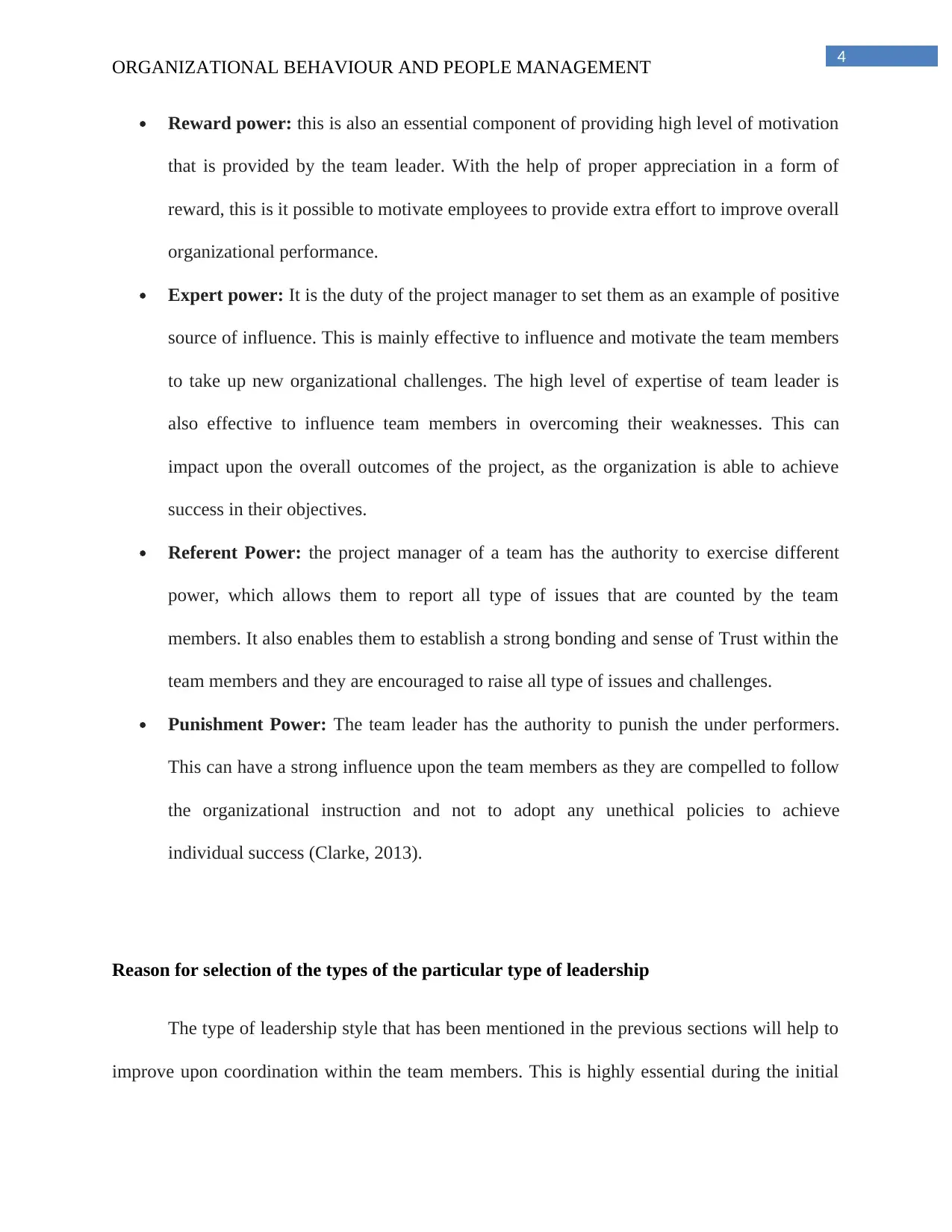
4
ORGANIZATIONAL BEHAVIOUR AND PEOPLE MANAGEMENT
Reward power: this is also an essential component of providing high level of motivation
that is provided by the team leader. With the help of proper appreciation in a form of
reward, this is it possible to motivate employees to provide extra effort to improve overall
organizational performance.
Expert power: It is the duty of the project manager to set them as an example of positive
source of influence. This is mainly effective to influence and motivate the team members
to take up new organizational challenges. The high level of expertise of team leader is
also effective to influence team members in overcoming their weaknesses. This can
impact upon the overall outcomes of the project, as the organization is able to achieve
success in their objectives.
Referent Power: the project manager of a team has the authority to exercise different
power, which allows them to report all type of issues that are counted by the team
members. It also enables them to establish a strong bonding and sense of Trust within the
team members and they are encouraged to raise all type of issues and challenges.
Punishment Power: The team leader has the authority to punish the under performers.
This can have a strong influence upon the team members as they are compelled to follow
the organizational instruction and not to adopt any unethical policies to achieve
individual success (Clarke, 2013).
Reason for selection of the types of the particular type of leadership
The type of leadership style that has been mentioned in the previous sections will help to
improve upon coordination within the team members. This is highly essential during the initial
ORGANIZATIONAL BEHAVIOUR AND PEOPLE MANAGEMENT
Reward power: this is also an essential component of providing high level of motivation
that is provided by the team leader. With the help of proper appreciation in a form of
reward, this is it possible to motivate employees to provide extra effort to improve overall
organizational performance.
Expert power: It is the duty of the project manager to set them as an example of positive
source of influence. This is mainly effective to influence and motivate the team members
to take up new organizational challenges. The high level of expertise of team leader is
also effective to influence team members in overcoming their weaknesses. This can
impact upon the overall outcomes of the project, as the organization is able to achieve
success in their objectives.
Referent Power: the project manager of a team has the authority to exercise different
power, which allows them to report all type of issues that are counted by the team
members. It also enables them to establish a strong bonding and sense of Trust within the
team members and they are encouraged to raise all type of issues and challenges.
Punishment Power: The team leader has the authority to punish the under performers.
This can have a strong influence upon the team members as they are compelled to follow
the organizational instruction and not to adopt any unethical policies to achieve
individual success (Clarke, 2013).
Reason for selection of the types of the particular type of leadership
The type of leadership style that has been mentioned in the previous sections will help to
improve upon coordination within the team members. This is highly essential during the initial
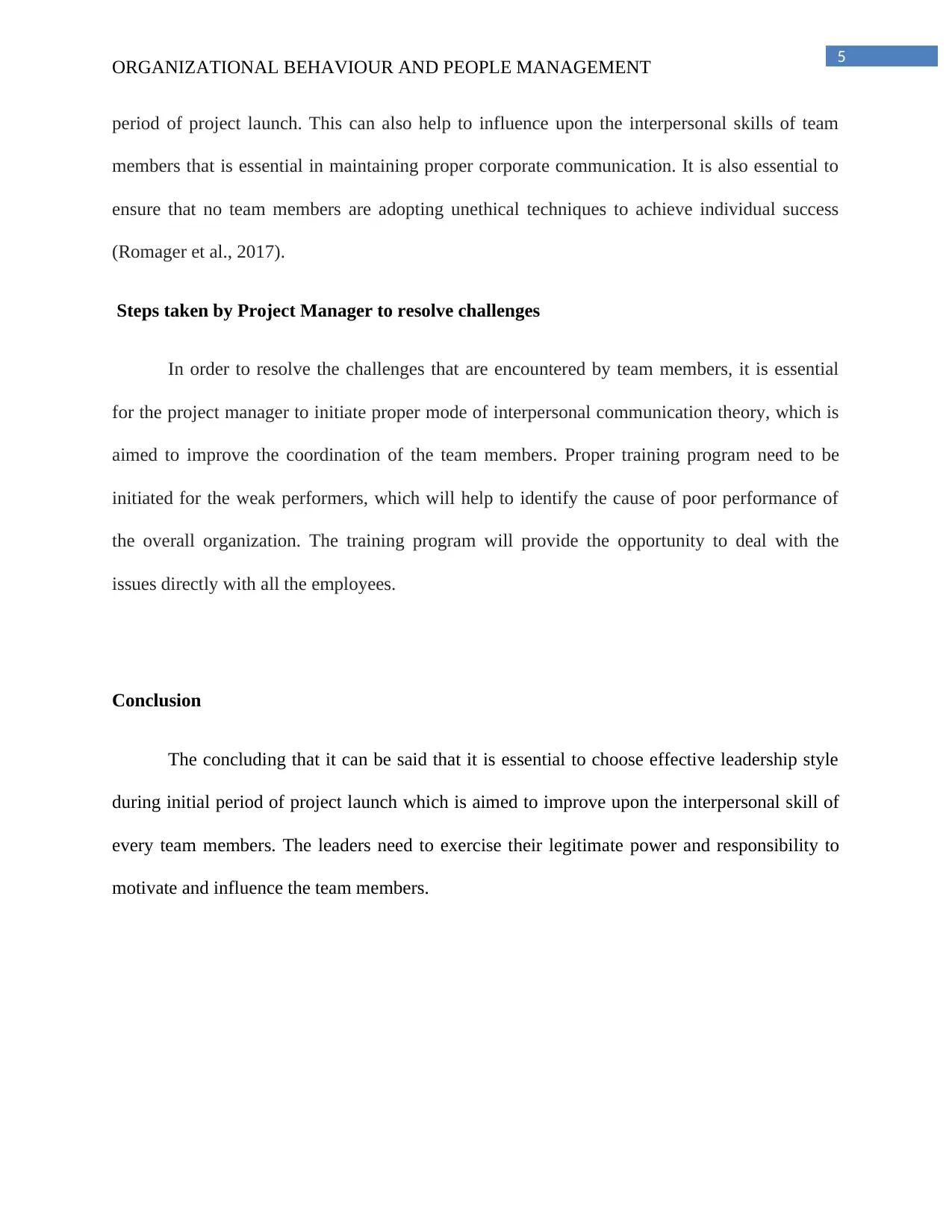
5
ORGANIZATIONAL BEHAVIOUR AND PEOPLE MANAGEMENT
period of project launch. This can also help to influence upon the interpersonal skills of team
members that is essential in maintaining proper corporate communication. It is also essential to
ensure that no team members are adopting unethical techniques to achieve individual success
(Romager et al., 2017).
Steps taken by Project Manager to resolve challenges
In order to resolve the challenges that are encountered by team members, it is essential
for the project manager to initiate proper mode of interpersonal communication theory, which is
aimed to improve the coordination of the team members. Proper training program need to be
initiated for the weak performers, which will help to identify the cause of poor performance of
the overall organization. The training program will provide the opportunity to deal with the
issues directly with all the employees.
Conclusion
The concluding that it can be said that it is essential to choose effective leadership style
during initial period of project launch which is aimed to improve upon the interpersonal skill of
every team members. The leaders need to exercise their legitimate power and responsibility to
motivate and influence the team members.
ORGANIZATIONAL BEHAVIOUR AND PEOPLE MANAGEMENT
period of project launch. This can also help to influence upon the interpersonal skills of team
members that is essential in maintaining proper corporate communication. It is also essential to
ensure that no team members are adopting unethical techniques to achieve individual success
(Romager et al., 2017).
Steps taken by Project Manager to resolve challenges
In order to resolve the challenges that are encountered by team members, it is essential
for the project manager to initiate proper mode of interpersonal communication theory, which is
aimed to improve the coordination of the team members. Proper training program need to be
initiated for the weak performers, which will help to identify the cause of poor performance of
the overall organization. The training program will provide the opportunity to deal with the
issues directly with all the employees.
Conclusion
The concluding that it can be said that it is essential to choose effective leadership style
during initial period of project launch which is aimed to improve upon the interpersonal skill of
every team members. The leaders need to exercise their legitimate power and responsibility to
motivate and influence the team members.
⊘ This is a preview!⊘
Do you want full access?
Subscribe today to unlock all pages.

Trusted by 1+ million students worldwide
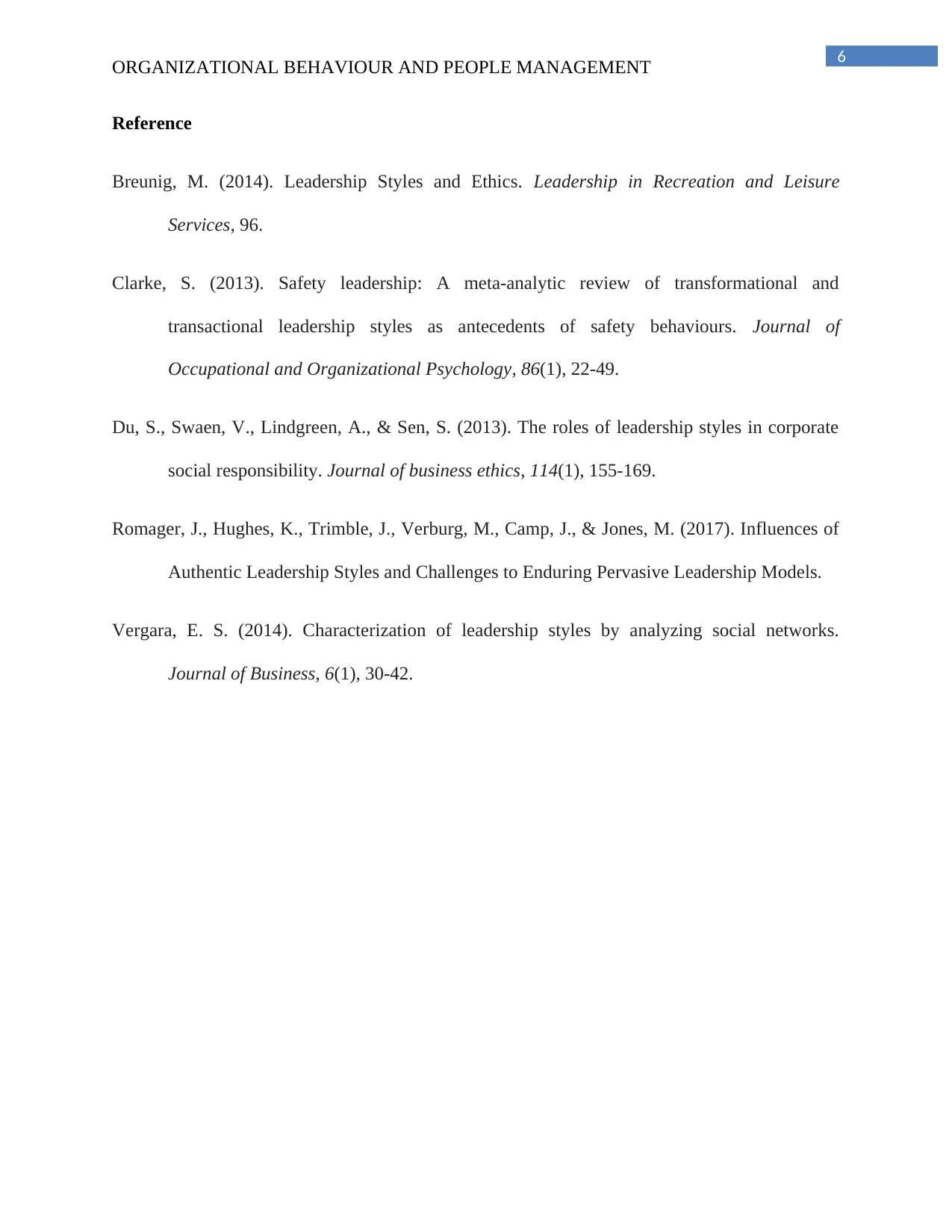
6
ORGANIZATIONAL BEHAVIOUR AND PEOPLE MANAGEMENT
Reference
Breunig, M. (2014). Leadership Styles and Ethics. Leadership in Recreation and Leisure
Services, 96.
Clarke, S. (2013). Safety leadership: A meta‐analytic review of transformational and
transactional leadership styles as antecedents of safety behaviours. Journal of
Occupational and Organizational Psychology, 86(1), 22-49.
Du, S., Swaen, V., Lindgreen, A., & Sen, S. (2013). The roles of leadership styles in corporate
social responsibility. Journal of business ethics, 114(1), 155-169.
Romager, J., Hughes, K., Trimble, J., Verburg, M., Camp, J., & Jones, M. (2017). Influences of
Authentic Leadership Styles and Challenges to Enduring Pervasive Leadership Models.
Vergara, E. S. (2014). Characterization of leadership styles by analyzing social networks.
Journal of Business, 6(1), 30-42.
ORGANIZATIONAL BEHAVIOUR AND PEOPLE MANAGEMENT
Reference
Breunig, M. (2014). Leadership Styles and Ethics. Leadership in Recreation and Leisure
Services, 96.
Clarke, S. (2013). Safety leadership: A meta‐analytic review of transformational and
transactional leadership styles as antecedents of safety behaviours. Journal of
Occupational and Organizational Psychology, 86(1), 22-49.
Du, S., Swaen, V., Lindgreen, A., & Sen, S. (2013). The roles of leadership styles in corporate
social responsibility. Journal of business ethics, 114(1), 155-169.
Romager, J., Hughes, K., Trimble, J., Verburg, M., Camp, J., & Jones, M. (2017). Influences of
Authentic Leadership Styles and Challenges to Enduring Pervasive Leadership Models.
Vergara, E. S. (2014). Characterization of leadership styles by analyzing social networks.
Journal of Business, 6(1), 30-42.
1 out of 7
Related Documents
Your All-in-One AI-Powered Toolkit for Academic Success.
+13062052269
info@desklib.com
Available 24*7 on WhatsApp / Email
![[object Object]](/_next/static/media/star-bottom.7253800d.svg)
Unlock your academic potential
Copyright © 2020–2025 A2Z Services. All Rights Reserved. Developed and managed by ZUCOL.




